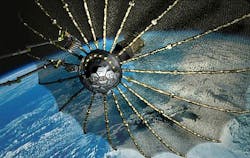Space scientists at NovaWurks to help DARPA reuse parts from orbiting dead satellites
ARLINGTON, Va., 18 Oct. 2013. U.S. military researchers are looking to designers at NovaWurks, Inc. in Los Alamitos Calif., for advanced work in a project to reuse satellite antennas, apertures, and other components from decommissioned satellites.
Spacecraft experts at the U.S. Defense Advanced Research Projects Agency (DARPA) in Arlington, Va., have awarded a potential $42.6 million contract for the second phase of the Phoenix program, which seeks to use still-good components from dead satellites parked in high-Earth orbit for building new satellites robotically while in orbit to reduce the costs of replacing failed satellites.
The contract has a base value $30.8 million, and four options collectively worth nearly $11.9 million. NovaWurks won a $2.9 million contract for the first phase of the DARPA Phoenix program in early 2012. Also working on Phoenix phase 1 were experts at MacDonald, Dettwiler and Associates Ltd. in Richmond, British Columbia.
DARPA officials say they expect to award additional Phoenix phase-2 and phase-3 contracts soon for a variety of technical work.
Phoenix seeks to demonstrate around-the-clock, globally persistent communication capability for warfighters more economically by robotically removing and re-using GEO-based space apertures and antennas from de-commissioned satellites in the graveyard or disposal orbit.
The Phoenix program seeks to redefine typical satellite subsystems for command and data handling, power, thermal, attitude control, and other subsystems. The program aims to do this by demonstrating a cellularized satellite architecture based on specialty cells. This is where NovaWurks experts come in.
Company researchers will investigate standardized cellular satellite construction that involves creating components of different sizes and performance for different-sized satellites, and non-traditional manufacturing of commercial off-the-shelf (COTS) components.
NovaWurks experts will seek to separate typical satellites into as many or as few components, and find ways to produce a cellular satellite architecture economically for aperture repurposing. satlet describes either one cellularized subsystem or component or one standalone cell-based system.
Typical satlet functions would include satellite antennas, stabilization and control subsystems, inter-satlet communication to share health and information, and power generation.
The company vision of NovaWurks is to provide access to the exploration of space for everyone -- not just space agencies, the government, or the military. The company seeks to enable the individual to capture instant, unaltered, affordable images of any location on the Earth at any time.
Through the Phoenix program, DARPA seeks to speed deployment of emerging technologies into on-orbit space systems at much lower cost than is possible today, DARPA officials say.
The idea behind Phoenix is that building new satellites robotically in orbit using recycled components would be much less expensive than simply junking failed satellites, and building and launching new ones from scratch.
These satellites would operate in geosynchronous orbit, which matches the speed of the Earth's rotation and makes them operate in one spot above the planet's surface. Stationary orbits are extremely high, and repairing or retrieving failing spacecraft at these distances today is nearly impossible.
Government experts have established a graveyard orbit high above the Earth's surface for disposing of decommissioned spacecraft where they pose little risk of colliding with functioning satellites. The graveyard orbit is necessary because de-orbiting these high-altitude satellites is dangerous and expensive.
Until now, the graveyard orbit has been a celestial junkyard filled with decommissioned satellites of no use to anyone. Even tough they no longer function, however, these junked satellites often still have useful components like antennas and sensors.
DARPA officials would like to develop technology able to launch orbiting robots that can salvage still-useful satellite components from the graveyard orbit and use them to build new satellites. Spacecraft in geosynchronous orbit are particularly useful for military and civil communications and persistent surveillance.
A previous DARPA solicitation requested industry proposals for satlets, a payload orbital delivery system (PODS) to orbit satlets quickly, and a separate on-orbit satellite servicing spacecraft with grasping mechanical arms and robotic tools to salvage spacecraft components and construct a new satellites.
For more information contact NovaWurks online at www.novawurks.com, or DARPA at www.darpa.mil.
EDITOR'S NOTE: A previous version of this story incorrectly characterized the work that NovaWurks will perform for DARPA as part of the second phase of the Phoenix program. In this phase of the program, NovaWurks is concentrating on cellurized satellite technology, also referred to as satlets, and not on orbiting salvage tools, as previously reported. Military & Aerospace Electronics regrets the error.
